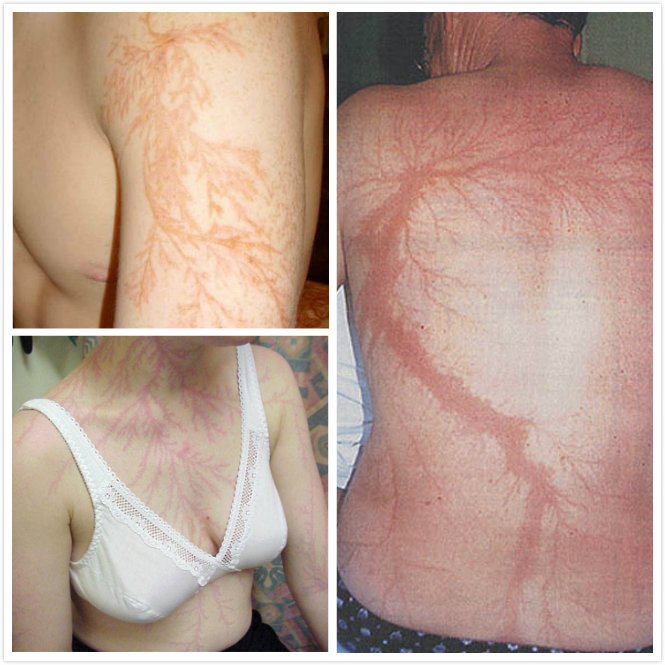Getting struck by lightning is quite an unusual occurrence. The statistics show that the chance of being struck by lightning in a lifetime is 1 out of 12000. Even with this small chance, about 90% of lightning victims survive to tell their tale. Lightning travels at tremendous speed to the earth and is thought to carry more power than that of a nuclear reactor. Imagine having that magnitude of power striking your body and still living to recount your experience!
What Do Lightning Scars on Body Look Like?
Characteristic lightning scars on the body are called the Lichtenberg scar. The name Lichtenberg was given to this type of pattern after the German physicist Georg Christoph Lichtenberg discovered and studied them in 1777. Scars created by a lightning strike have characteristic scarring which is paradoxically quite beautiful considering the destructive force that created it and the threat it poses to life. Once struck by a bolt of lightning, the electrical energy in the current has to leave the body to reach the earth. This means the victim will have entry and exit wounds.

The lightning scars on body may be caused by blood vessels bursting as the current travels through the body, heats up and subsequently destroys the affected blood vessels. This distinguishing pattern is also seen on the surfaces or interior of insulating materials after electrical current discharges on or in the insulating material. The pattern created is also referred to as a fractal pattern. It resembles the fine, intricate branching of a fern or crystallization process.
What Else May Happen in Lightning Strikes?
The speed at which the lightning courses through a human body is a mere 3 milliseconds. Depending upon how and where the lightning strikes, damage can be extreme like death, or only partial if the lightning entered and exited, affecting only a small part of the body.
1. Burns
These wounds will be in addition to the usual third degree burns. Some victims have hair and clothes that become singed. The three milliseconds it takes to be struck by a bolt of lightning will deliver intense pain as the force of the electrical current sears through your body. Any metal objects on the body, like jewelry, will conduct this current and become superheated causing burns to the skin, leaving lightning scars on body. If the feet are the exit point, shoes may be blown off by the force.
2. Heart Damage
The force of the electricity passing through the body has the potential to cause the heart to stop beating and death. The lightning may affect the normal electrical impulses regulating heartbeat.
3. Brain Damage
The muscles of the respiratory system can become paralyzed, causing a lack of oxygen to the brain. Brain damage may also occur if struck on the head. Permanent paralysis or areas of numbness can also be the result.
4. Neural Damage
Some people experience muscle twitches that can resemble symptoms of Parkinson's disease. This is due to neural damage. Other neural consequences of a lightning strike are impaired reflexes, memory inconsistencies, depression, anxiety, dementia. Some victims suffer from shattered eardrums.
What to Do If Someone Is Struck by Lightning
Although the lightning scars on body look amazing, being struck is very dangerous. If you find someone having been struck, remain calm and follow the measures below:
- Ensure the area is safe for you or other first aiders before you touch the victim or enter the immediate vicinity.
- Call for help. This can be getting someone to ring for the emergency services or doing it yourself.
- Avoid moving the victim unless there is still a danger to his life. This helps to prevent further damage to the body as you haven't fully assessed the injuries yet. The victim may have spinal injuries. Unnecessary movement without the proper immobilization can further damage the spine.
- Check for breathing and administer CPR if necessary. Continue the cycles of compressions until help arrives.
- If the victim is breathing comfortably and after a comprehensive first-aid type of assessment, provide treatment for shock, fractures, burns or hypothermia if the victim exhibits signs of these injuries.
- Remove the victim to a hospital for further evaluation and treatment.
How to Avoid Lightning Strikes
- If you are outdoors, pay close attention to the weather. It may also be worthwhile to check the weather forecast for your area if you're planning outdoor activities and postpone your activities for a more suitable time.
- If you're caught in a storm unavoidably, take shelter in a building or even a car. Lightning that strikes a car travels through the metal of the car rather than your body.
- Avoid trees because taller objects will attract the lightning bolt.
- Avoid large open areas as well. Higher and water logged ground also increases the chances of being struck.
- Many buildings in high risk areas for lightning storms have lightning rods installed onto the roof. The rod has copper wire within and a conductive grid buried underground. This rod attracts the lightning but safely discharges it into the ground, thus avoiding injury to the people within and damage to the building.
- Crouch low with your feet together and your head between your knees. This position will protect your heart and other vital organs if you are struck by the electricity.
- Never lie down flattening yourself on the ground, as this will make you a bigger target touching the earth where the electricity will discharge.
- Avoid using a landline to place a call. If the telephone line is struck, the electric current could theoretically travel to the phone in your hands.
- Don't touch any water pipes as these may conduct electricity. This warning also includes avoiding fences, metal poles and even umbrellas.